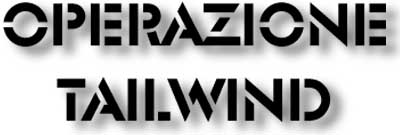
|
Dopo aver fatto uscire questa storia Cnn & Time hanno fatto marcia indietro dicendo che dopo le contestazioni di centinaia di veterani del Vietnam, hanno fatto degli approfondimenti ed alla fine non hanno avuto la certezza dell'uso del gas nervino. Ed hanno chiesto scusa per l'avventatezza con cui hanno dato la notizia. Mentre una delle produttrici del programma, April Oliver, ha fortemente criticato la marcia indietro della CNN, affermando che la multi delle news non vuole contrasti con l'establishment del Pentagono, vuole evitare spiacevoli controversie con i militari, ed era anche minacciatsa di boicottaggio dalle associazioni dei veterani del Vietnam, quindi la marcia indietro. E' quello che pensiamo anche noi. April Oliver, appearing on ABC's "Good Morning America" on Sunday, defended her work and criticized CNN management for its retraction. "They couldn't take the heat, they couldn't take the military establishment coming down on them, they were threatened with a boycott by veterans ... they didn't want to take the controversy," she was quoted in an ABC transcript as stating on the program. CNNís "Tailwind" and Selective Media Retractions - il rapporto di FAIR |

Washington (CNN) 7 giugno 1998
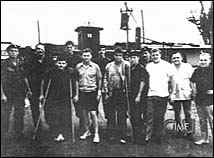 Gli Stati Uniti usarono gas nervino in una missione per uccidere dei disertori americani in Laos durante la gurra del Vietnam nel 1970. Questo e' il risultato di un inchiesta giornalistica durata 8 mesi condotta da "NewsStand: CNN & Time."
Gli Stati Uniti usarono gas nervino in una missione per uccidere dei disertori americani in Laos durante la gurra del Vietnam nel 1970. Questo e' il risultato di un inchiesta giornalistica durata 8 mesi condotta da "NewsStand: CNN & Time."
Il reportage si basa su interviste a piu' di 200 persone, decine delle quali combatterono e furono operative in questa missione, chiamata Operazione Tailwind.
L'ex ammiraglio Thomas Moorer, in Vietnam era capo delle operazioni navali ed era nello staff di direzione delle operazioni, ha dichiarato che l'unita' di National Security della Casa Bianca (c'era Nixon presidente) ha approvato l'uso del gas nervino e che anche la CIA era coinvolta nell'Operazione Tailwind.
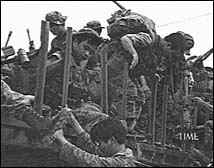 Ha anche dichiarato in un intervista a telecamera chiusa che il bersaglio di questa operazione erano disertori americani.
Ha anche dichiarato in un intervista a telecamera chiusa che il bersaglio di questa operazione erano disertori americani.
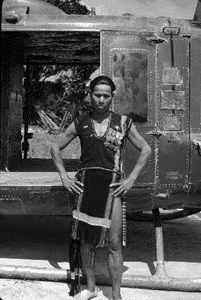 I Montagnard erano dei mercenari di un gruppo indigeno delle montagne centrali del Vietnam. Questi soldati facevano parte del SOG - Studies and Observation Group - una piccola unita' d'elite delle U.S. Special Forces.
I Montagnard erano dei mercenari di un gruppo indigeno delle montagne centrali del Vietnam. Questi soldati facevano parte del SOG - Studies and Observation Group - una piccola unita' d'elite delle U.S. Special Forces.
Gli SOG venivano usati per "black operations", operazioni sporche, contro bersagli inusuali, con armi inusuali. Per l'Operazione Tailwind era stato detto agli ufficiali che avevano tutta la disponibilita' dell'arsenale USA, fatta eccezione per le armi nucleari.
Questo arsenale includeva anche un'arma nota come "sleeping gas".
Gli ufficiali a conoscenza dell'operazione concordano sul fatto che questo "sleeping gas" era difatto un gas nervino, il sarin per la precisione - lo stesso usato negli attentati nella metrpolitana di Tokyo il 20.3.95. Il nome militare di questo gas era GB.
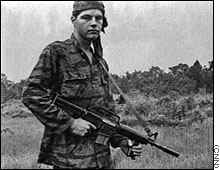 Pochi giorni prima che l'unita' d'elite iniziasse la missione, un team di ricognizione aveva controllato l'area del Laos alla ricerca di disertori. Jay Graves, un caposquadra dei ricognitori comunico' per radio che aveva visto gente con aspetto caucasico, non con occhi a mandorla, in una base/villaggio. Gli venne detto di aspettare e nascondersi.
Pochi giorni prima che l'unita' d'elite iniziasse la missione, un team di ricognizione aveva controllato l'area del Laos alla ricerca di disertori. Jay Graves, un caposquadra dei ricognitori comunico' per radio che aveva visto gente con aspetto caucasico, non con occhi a mandorla, in una base/villaggio. Gli venne detto di aspettare e nascondersi.
Anche Jim Cathey dell'aviazione rimase per 5 ore ad osservare il villaggio e quello che vide, come Graves, in quel villaggio erano soldati americani.
"Credo che fosse un gruppo di soldati americani disertori perche' potevano muoversi nel villaggio senza alcuna restrizione".
Dal momento che la forza SOG venne dispiegata sul terreno dovette stare in combattimento continuamente. Dopo tre giorni piu' della meta' degli uomini erano feriti ed avevano poche munizioni.
Come raccontato dagli ufficiali americani, durante la sera, aerei americani "gasarono" il campo con il micidiale sarin, usando un'arma speciale, CBU 15, una bomba a grappolo disegnata per trasportare gas nervino.
La mattina dopo le unita' speciali attaccarono il campo, e come di ce McCarley e gli altri veterani dell'Operazione Tailwind, uccisero piu' di 100 persone.
 Il tenente Robert Van Buskirk, uno dei capi plotone, colpi' due caucasici (bianchi). loro corsero via e si rifugiarono in un tunnel. Convinto che fossero disertori Van Buskirk gli sparo' dentro una granata al fosforo bianco. Crede di averli uccisi entrambi.
Il tenente Robert Van Buskirk, uno dei capi plotone, colpi' due caucasici (bianchi). loro corsero via e si rifugiarono in un tunnel. Convinto che fossero disertori Van Buskirk gli sparo' dentro una granata al fosforo bianco. Crede di averli uccisi entrambi.I commandos esercitarono tutta la potenza di fuoco disponibile distruggendo il campo in circa 10 minuti.
John Singlaub, un ex commando SOG, ha dichiarato che era molto piu' importante uccidere i disertori americani, che non i nemici, per la sopravvivenza delle truppe USA. Poiche' i disertori avevano conoscenze delle tattiche e dei mezzi di comuinicazione e potevano percio' essere percolosi.
 I Montagnard dissero ai loro superiori americani che tra i morti del villaggio c'erano dei corpi di uomini che sembravano essere americani. Van Buskirk e gli altri SOG dissero che nessuno andava identificato e che nessuno andava riportato indietro.
I Montagnard dissero ai loro superiori americani che tra i morti del villaggio c'erano dei corpi di uomini che sembravano essere americani. Van Buskirk e gli altri SOG dissero che nessuno andava identificato e che nessuno andava riportato indietro.
Diversi ex alti ufficiali hanno dichiarato alla CNN che uccidere i disertori era l'obiettivo dell'Operazione Tailwind, ma McCarley nega che questo fosse l'obiettivo della missione.
"No stavamo cercando nessun villaggio... ci capito' li per caso".
Due A1 Skyraider bombardarono con gli speciali ordigni CBU 15 al sarin, le posizioni nemiche. L'effetto del gas fu immediato. Michael Hagen un veterano dell'Operazione Tailwind ha descritto come ha visto i soldati nemici in convulsioni e vomito. "Non penso che ne siano sopravvissuti molti".
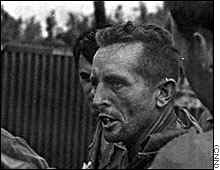 Alcuni americani ed altri Montagnard avevano perso o danneggiato le maschere durante i quattro giorni di combattimenti. Hanno descritto muco uscire dalle membrane, vomito e convulsioni - tutti segni classici di esposizione al gas nervino.
Alcuni americani ed altri Montagnard avevano perso o danneggiato le maschere durante i quattro giorni di combattimenti. Hanno descritto muco uscire dalle membrane, vomito e convulsioni - tutti segni classici di esposizione al gas nervino.
Ma i commandos SOG ne ebbero una dose leggera perche' le eliche degli elicotteri arrivati a portarli via dispersero il gas. Tutti e 16 i componenti americani del commando, sebbene feriti sopravvissero all'operazione.
Did The U.S. Drop Nerve Gas?
A CNN investigation charges that the U.S. used gas in 1970 to save troops sent into Laos to kill defectors
By APRIL OLIVER AND PETER ARNETT
September 1970. Sixty miles inside Laos, where it was not officially supposed to be, a battered and exhausted U.S. Special Forces commando unit was in very deep trouble. Nearly every one of the Americans and many of the Montagnard mercenaries fighting with them had been wounded. They had just wiped out a village base camp, killing about 100 people that included not only women and children but also what some believed to be a group of American G.I.s who had defected to the enemy. Now their unit was under assault by a superior force of North Vietnamese and communist Pathet Lao soldiers.
The enemy troops had appeared suddenly on a nearby ridge, and were about to cut off the Americans as they tried to reach a rice paddy where rescue helicopters would land to fly them out of officially neutral Laos, back to their base in Vietnam. "The enemy was coming at us. We were out of ammo," recalls platoon leader Robert Van Buskirk, then a 26-year-old lieutenant. His only recourse was to call for help from the air. He radioed an Air Force controller above to call in two waiting A-1 Skyraiders to drop the "bad of the bad."
Within seconds, the Skyraiders swooped over the advancing enemy and dropped gas canisters, scoring a direct hit. The G.I.s heard the canisters exploding and saw a wet fog envelop the Vietnamese soldiers as they dropped to the ground, vomiting and convulsing. As the rescue choppers lifted his unit off, Van Buskirk manned a machine gun, scanning the elephant grass for targets, but there were none. "All I see is bodies," he recalls. "They are not fighting anymore. They are just lying, some on their sides, some on their backs. They are no longer combatants."
Now, after an eight-month investigation, military officials with knowledge of the mission assert to NewsStand: CNN & TIME that the gas dropped 28 years ago in Laos was nerve gas, specifically sarin, the lethal agent used in the 1995 terrorist attack in a Tokyo subway that killed a dozen people. Although the nerve gas, called GB by the military, had been in the U.S. arsenal for years and the U.S. had not yet ratified the Geneva Protocol banning its use, the policy of the Nixon Administration was "no first use" of lethal nerve gas in combat.
A Pentagon official has told NewsStand: CNN & TIME that the Army "has found no documentary evidence to support CNN's claims that nerve gas of any type was used on Operation Tailwind." But Admiral Thomas Moorer, U.S.N. (ret.), Chairman of the Joint Chiefs in 1970, and other top military officials have confirmed the use of sarin in the Laotian operation and in other missions to rescue downed U.S. airmen during the Vietnam War. Moorer argues the use of the gas was justified under the circumstances. Says he: "I would be willing to use any weapon and any tactic to save the lives of American soldiers."
In addition to using the nerve gas to extract the Americans after their raid, though, veteran Special Forces officers claim to NewsStand: CNN & TIME that sarin was also used the night before the assault to "prepare" the village for the attack the next morning. This would indicate that civilians as well as combatants were victims of poison gas.
Just as surprising as the use of the gas is the reason for the raid: the targeted village was believed to be harboring a large group of American G.I.s who had defected to the enemy. The Special Forces unit's job was to kill them.
Based in Kontum, South Vietnam, the men involved in Operation Tailwind were known as a SOG team, standing innocuously for Studies and Observations Group. Officially, SOG units didn't exist, but they were America's fiercest warriors, conducting classified "black operations" with unconventional weapons and unusual targets. They did little studying and a lot of fighting. According to SOG veterans, they had no rules of engagement: anything was permissible as long as it was deniable. Their motto, according to Van Buskirk: "Kill them all, and let God sort it out."
During its preraid briefing at Kontum, the SOG "hatchet force" was told to kill anyone it encountered. "My orders were, if it's alive, if it breathes oxygen, if it urinates, if it defecates, kill it," says Van Buskirk. In keeping with the compartmentalization of information necessary to protect top-secret missions, only a few of the SOG officers knew the precise target. And very few knew the exact type of gas available for their mission, although the unit was promised anything in the non-nuclear U.S. arsenal it might need to complete the mission. The commandos understood there was an agent commonly known as "sleeping gas" available for last-resort situations; they were aware that the gas caused respiratory distress, sudden vomiting, diarrhea, convulsions and often death. The unit leaders were advised to equip their soldiers with bulky but effective M-17 gas masks before the raid.
Several days before the operation began, a small reconnaissance force was dropped into a lush Laotian valley near the town of Chavan. As Jay Graves, a SOG recon-team leader, put it, "We went in, snooped and pooped, moved around." Through a special field telescope, Graves' men spotted the prize--several "roundeyes," Americans, in the village. That report was radioed back, and the recon team was told to "groundhog"--remain silent and in hiding until the hatchet force arrived. The sighting of defectors is confirmed today by Air Force "rat-pack" commando Jim Cathey. "I believed that these were American defectors," he says, "because there was no sign of any restraint. They walked around as though they were a part of the bunch."
On Sept. 11 the 16 SOG-team members and about 140 Montagnard tribesmen, who had been hired to fight the communists, were loaded aboard four big Marine helicopters at Dak To, near the border with Laos. The sight of the assault force, which included 12 Cobra helicopter gunships and two backup Marine choppers, alerted Jack Tucker, one of the Marine pilots, that trouble lay ahead. "I saw them walking across the tarmac, loaded down with those grenade clips," he says. "And there were these little bitty Montagnards humping so much stuff. I just went 'Oh, man' and knew we were in for some real deep shit." Tucker and the other pilots had also been equipped with special gas masks to protect against chemical warfare.
As soon as the helicopters approached the landing zone near Chavan, they came under heavy fire. "It was a hairy situation from the time we got there, " recalls Jimmy Lucas, a squad leader. "Ground fire on insertion is something you are not supposed to get." The SOG team hit the ground several miles from the targeted base camp and spent the next three days fighting its way toward it. "I feel like in them three days I just cheated death," says Lucas. "We never expected to come out. I didn't."
On the third night the commandos hunkered down near the village as the Air Force A-1s "prepped" the target. In the morning the SOG forces attacked. Van Buskirk's platoon led the charge. "I went hi diddle diddle, right up the middle. I was on the offensive," he says. Tossing grenades into the hootches in the village and spraying machine-gun fire ahead, the assault force met little resistance. "It was minimal, nothing like you would expect for the amount of people there," says Craig Schmidt, a fighter in Van Buskirk's platoon. "It was very unusual, kind of eerie."
Suddenly Van Buskirk spotted two "longshadows," a name for taller Caucasians. One was sliding down a "spider hole" into the underground-tunnel system beneath the camp. The other was running toward it. "Early 20s. Blond hair. Looks like he was running off a beach in California," remembers Van Buskirk. "Needs a haircut. This is a G.I. Boots on. Not a prisoner. No shackles. Nothing." The lieutenant gave chase but just missed the blond man as he slipped into the tunnel. He shouted down the hole, identifying himself and offering to take the man home. "Fuck you," came the reply. "No, it's fuck you," answered Van Buskirk as he dropped in a white phosphorus grenade, presumably killing both longshadows.
The village raid lasted no more than 10 minutes. The body count, according to Captain Eugene McCarley, the officer in charge, was "upwards of 100." Sergeant Mike Hagen says "the majority of the people there were not combat personnel. The few infantry people they had we overran immediately. We basically destroyed everything there." The Montagnards searched the camp for documents and booty. They reported to Hagen and Van Buskirk that there were "beaucoup roundeyes" dead in the hootches. Says Van Buskirk: "A dozen, 15, maybe 20." But the SOG team says no bodies were identified or recovered.
With the camp destroyed, spotter planes overhead ordered the SOG unit to the rice paddy where the rescue helicopters would land. As the enemy closed in, the commandos were told to don their "funny faces," the M-17 gas masks. Then came the explosions of the gas canisters. "To me it was more of a very, very light, light fog. It was tasteless, odorless, you could barely see it, " recalls Hagen.
The gas spread toward the Americans even though the downwash of the chopper blades was pushing it away. Some of the gas masks had been damaged in the four-day battle, some had been discarded, and some were too big for the diminutive Montagnards. "Everything got sticky," says squad leader Craig Schmidt. "We turned our sleeves down to cover ourselves as much as possible. It doesn't surprise me in the slightest bit that it was nerve gas. It worked too well." Some of the Americans began vomiting violently. Today Hagen suffers from creeping paralysis in his extremities, which his doctor diagnoses as nerve-gas damage. "Nerve gas," says Hagen, "the government don't want it called that. They want to call it incapacitating agent or some other form. But it was nerve gas."
As many as 60 of the Montagnards died in Operation Tailwind, but all 16 Americans got out alive, although every one of them suffered some wounds. Van Buskirk and McCarley earned the Silver Star for valor. Van Buskirk personally briefed General Creighton Abrams, the top U.S. commander in Vietnam, on the mission. But when the lieutenant wrote his after-action report, a superior officer, now deceased, advised him to delete the part about dropping the white phosphorus grenade--a "willy pete," in Army lingo--on the American defectors in the tunnel.
Confirming the use of sarin, Moorer says the gas was "by and large available" for high-risk search-and-rescue missions. Sources contacted by NewsStand: CNN & TIME report that GB was employed in more than 20 missions to rescue downed pilots in Laos and North Vietnam. Concludes Moorer: "This is a much bigger operation than you realize."
Melvin Laird, Secretary of Defense at the time of Operation Tailwind, says he has no specific recollection of GB being used, but adds, "I do not dispute what Admiral Moorer has to say on this matter." And the admiral points out that any use of nerve gas would have had approval from the Nixon national-security team in Washington. Henry Kissinger, National Security Adviser at the time, declined to comment.
As for the defectors and the policy of killing them, Major General John Singlaub, U.S.A. (ret.), a former SOG commander, confirms what was the unwritten SOG doctrine in effect at the time: "It may be more important to your survival to kill the defector than to kill the Vietnamese or Russian." The defectors' knowledge of U.S. communications and tactics "can be damaging," he explains.
"There were more defectors than people realize," says a SOG veteran at Fort Bragg. No definitive number of Americans who went over to the enemy is available, but Moorer indicated there were scores. Another SOG veteran put the number at close to 300. The Pentagon told NewsStand: CNN & TIME that there were only two known military defectors during the Vietnam War.
--Additional reporting by Amy Kasarda, associate producer for NewsStand, and Jack Smith, senior producer for NewsStand
APRIL OLIVER is a producer for NewsStand, and PETER ARNETT Is a CNN international correspondent
OPERATION TAILWIND In Sept. 1970 a "hatchet force" was assigned to wipe out a Laotian village suspected of harboring American defectors. The commandos were promised any weapon they might need, including an agent they called "sleeping gas," for "last resort" situations.
RETRACTIONS OF REPORTING ARE QUITE SELECTIVE
By Norman Solomon / Creators Syndicate
Judging from the uproar about recent retractions by CNN
and Time magazine, you might conclude that American
journalism maintains high standards for war-related
reporting -- and sets the record straight when those
standards aren't met. But nothing could be farther from
the truth.
Early this month, under enormous pressure, CNN and Time
retracted their joint reports in June that said the U.S.
military used nerve gas against American defectors in
Laos during the Vietnam War. But it would be a big
mistake to assume that inaccurate stories will get
retracted.
News accounts routinely serve as conveyor belts for
dubious information from high-ranking officials in
Washington. Those sources, often unnamed, are apt to
provide self-serving mixtures of facts and falsehoods.
But if no one in a powerful position raises a squawk,
then there's rarely any pressure for a correction, much
less a retraction. On the contrary, officials are
appreciative of a story -- however untrue -- if it moves
their agendas forward.
That's how lies can routinely be reported as truth --
with tragic consequences.
Here's a momentous example: For a third of a century,
U.S. media outlets have not bothered to retract their
false reporting of events in the Gulf of Tonkin.
On Aug. 5, 1964, American news media reported that North
Vietnamese forces -- for the second time in three days
-- had launched unprovoked attacks on U.S. ships in the
Tonkin Gulf.
Across the United States, front pages presented
fabrications as facts. The New York Times proclaimed
that the U.S. government was retaliating "after renewed
attacks against American destroyers in the Gulf of
Tonkin." The Washington Post's headline typified the
national spin: "American Planes Hit North Vietnam After
Second Attack on Our Destroyers; Move Taken to Halt New
Aggression."
Two days later, the Gulf of Tonkin Resolution -- the
closest thing there ever was to a declaration of war
against North Vietnam -- gained nearly unanimous
approval from Congress. The resolution authorized the
president "to take all necessary measures to repel any
armed attack against the forces of the United States and
to prevent further aggression."
But the attack by North Vietnam on Aug. 2 wasn't
"unprovoked." And the "second attack" never occurred.
But as months became years and then decades, major U.S.
media outlets still didn't issue a retraction.
During the last few days, I asked a number of Washington
Post staffers whether the newspaper ever retracted its
Tonkin Gulf reporting. Finally, the trail led to someone
with a definitive answer.
"I can assure you that there was never any retraction,"
said Murrey Marder, a reporter who wrote much of the
Washington Post's coverage of August 1964 events in the
Gulf of Tonkin. He added: "If you were making a
retraction, you'd have to make a retraction of virtually
everyone's entire coverage of the Vietnam War."
Marder remembers that the U.S.-backed South Vietnamese
navy had been shelling North Vietnamese coastal islands
just prior to the reported attacks by North Vietnam on
U.S. ships in the Tonkin Gulf. But the propaganda
machinery was in high gear: "Before I could do anything
as a reporter, the Washington Post had endorsed the Gulf
of Tonkin Resolution."
The news coverage of events in the Tonkin Gulf "was all
driven by the White House," recalled Marder, who was a
Post reporter from 1946 to 1985. "It was an operation --
a deliberate manipulation of public opinion. ... None of
us knew, of course, that there had been drafted, months
before, a resolution to justify American direct entry
into the war, which became the Gulf of Tonkin
Resolution."
Marder commented: "If the American press had been doing
its job and the Congress had been doing its job, we
would never have been involved in the Vietnam War."
Since then, U.S. forces invaded Grenada and Panama in
the 1980s and made war on Iraq in the 1990s. Less direct
intervention from Washington, in Central America and
elsewhere, also took many lives. In the process, quite a
few journalists enhanced their careers by more or less
telling the favorite stories of the Pentagon, the State
Department and the White House.
Reliance on official sources has remained a routine part
of news coverage. And the biggest problems with American
journalism still include stories that never get
retracted.
Whats new on Revolt
http://flag.blackened.net/revolt/new.html
@@@@@@@@@@@@@@@@@@@@@@@@@@@@@@@@@@@@@@@@@@@
International Anarchist Web Page
http://flag.blackened.net/revolt/inter.html
International Class Struggle anarchist discussion list,
contact platform@geocities.com for details
Guestbook http://www.geocities.com/CapitolHill/6170/